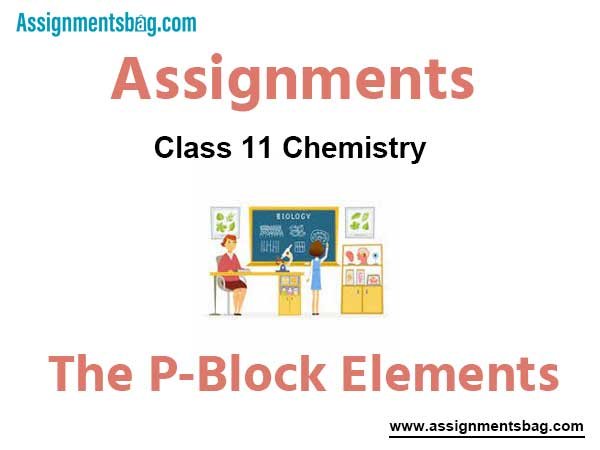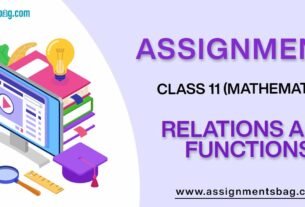Please refer to Assignments Class 11 Chemistry The p-Block Elements Chapter 11 with solved questions and answers. We have provided Class 11 Chemistry Assignments for all chapters on our website. These problems and solutions for Chapter 11 The p-Block Elements Class 11 Chemistry have been prepared as per the latest syllabus and books issued for the current academic year. Learn these solved important questions to get more marks in your class tests and examinations.
The p-Block Elements Assignments Class 11 Chemistry
Question. The structure of diBorane contains
(a) Four 2c – 2e bonds and two 3c – 2e bonds
(b) Two 2c – 2e bonds and two 3c – 2e bonds
(c) Two 2c – 2e bonds and two 3c – 3e bonds
(d) Four 2c – 2e bonds and four 3c – 2e bonds
Answer
A
Question. Among the C-X bond (where, X = Cl, Br, I) the correct decreasing order of bond energy is
(a) C−I > C−Cl > C−Br
(b) C−I > C−Br > C−Cl
(c) C−Cl > C−Br > C−I
(d) C−Br > C−Cl > C−I
Answer
C
Question. Borax is used as a cleansing agent because on dissolving in water, it gives
(a) Alkaline solution
(b) Acidic solution
(c) Bleaching solution
(d) Amphoteric solution.
Answer
A
Question. All the elements of oxygen family are
(a) Non metals
(b) Metalloids
(c) Radioactive
(d) Polymorphic
Answer
D
Question. Which of the following is not a mineral of boron?
(a) Colemanite
(b) Kernite
(c) Boric Anhydride
(d) Borax
Answer
C
Question. Consider the following statement about Ozone I. O3 is formed by the interaction of fluorine. II. It turns tetramethyl base paper as violet. III. It turns benzidine paper as brown. The correct set of true statement is
(a) I and II
(b) I, II and III
(c) I and III
(d) II and III
Answer
B
Question. There is no S-S bond in
(a) S2O2- 4
(b) S2O2- 5
(c) S2O2- 3
(d) S2O2- 7
Answer
D
Question. Graphite is a soft solid lubricant extremely diffcult to melt. The reason for this anomalous behaviour is that graphite.
(a) Has carbon atoms arranged in large plates of rings of strongly bound carbon atoms with weak interplate bonds
(b) Is a non – crystalline substance
(c) Is an allotropic from of carbon
(d) Has molecules of variable molecular masses like polymers.
Answer
A
Question. Which is strongest Lewis acid?
(a) BF3
(b) BCl3
(c) BBr3
(d) BI3
Answer
A
Question. Amorphous form of Silica is
(a) Tridymite
(b) Kieselguhr
(c) Cristobalite
(d) Quartz
Answer
C
Question. Which among CH4, SiH4, GeH4 and SnH4 is most volatile?
(a) CH4
(b) SiH4
(c) GeH4
(d) SnH4
Answer
A
Question. Which of the following bonds has the most polar character?
(a) C – O
(b) C – Br
(c) C – S
(d) C – F
Answer
D
Question. Amongst the halides
(1) BCl3
(2) AlCl3
(3) GaCl3
(4) InCl3
the order of decreasing Lewis acid character is
(a) 1, 2, 3, 4
(b) 4, 3, 2, 1
(c) 3, 4, 2, 1
(d) 2, 3, 4, 1
Answer
A
Question. Carbon forms a large number of compounds because it has
(a) fixed valency
(b) non-metallic nature
(c) high ionization potential
(d) property of catenation.
Answer
D
Question. Thallium shows different oxidation states because
(a) of its high reactivity
(b) of inert pair of electrons
(c) of its amphoteric nature
(d) it is a transition metal.
Answer
B
Question. The +1 oxidation state of thallium is more stable than its +3 oxidation state because of
(a) its atomic size
(b) its ionisation potential
(c) inert pair effect
(d) diagonal relationship.
Answer
C
Question. Ionisation enthalpy (ΔiH1 kJ mol–1) for the elements of Group 13 follows the order
(a) B > Al > Ga > In > Tl
(b) B < Al < Ga < In < Tl
(c) B < Al > Ga < In > Tl
(d) B > Al < Ga > In < Tl
Answer
D
Question. In graphite, electrons are
(a) localised on every third C-atom
(b) present in anti-bonding orbital
(c) localised in each C-atom
(d) spread out between the structure.
Answer
D
Question. The shape and hybridisation of Si(CH3)4 is
(a) bent, sp
(b) trigonal, sp2
(c) tetrahedral, sp3
(d) octahedral, sp3d2
Answer
C
Question. Which of the following statements is correct?
(a) Graphite is thermodynamically more stable than diamond.
(b) Diamond is thermodynamically more stable than graphite.
(c) Graphite has such a high thermodynamical stability that diamond spontaneously changes into graphite in ordinary conditions.
(d) Graphite and diamond have equal thermodynamic stability.
Answer
A
Question. In group 13, electronegativity first decreases from B to Al and then increases marginally down the group. This is because of
(a) non-metallic nature of B
(b) discrepancies in atomic size of elements
(c) ability of B and Al to form pp – pp multiple bonds
(d) irregular trend in electronegativity throughout the periodic table.
Answer
B
Question. Which of the following acts as an oxidising agent?
(a) B3+
(b) Al3+
(c) Tl3+
(d) None of these
Answer
C
Question. The wrong statement about fullerene is
(a) it has 5-membered carbon ring
(b) it has 6-membered carbon ring
(c) it has sp2 hybridization
(d) it has 5-membered rings more than 6-membered rings.
Answer
D
Question. The exhibition of highest co-ordination number depends on the availability of vacant orbitals in the central atom. Which of thefollowing elements is not likely to act as central atom in MF63– ?
(a) B
(b) Al
(c) Ga
(d) In
Answer
A
Question. Choose the correct statement.
(a) Non-metals have higher ionisation enthalpies and higher electronegativities than the metals.
(b) Non-metals and metalloids exist only in the p-block of the periodic table.
(c) Change of non-metallic to metallic character can be illustrated by the nature of oxides they form.
(d) All are correct.
Answer
D
Question. Match the species given in Column I with the properties mentioned in Column II.

(a) (i) → (E), (ii) → (B), (iii) → (D), (iv) → (A, C)
(b) (i) → (E), (ii) → (C), (iii) → (D), (iv) → (A, B)
(c) (i) → (B), (ii) → (E), (iii) → (D), (iv) → (A, C)
(d) (i) → (D), (ii) → (E), (iii) → (B), (iv) → (A, C)
Answer
B
Question. Elements of group 14
(a) exhibit oxidation state of +4 only
(b) exhibit oxidation state of +2 and +4 only
(c) form M2– and M4+ ions
(d) form M2+ and M4– ions.
Answer
B
Question. Which of the following does not have a tetrahedral structure?
(a) BH3
(b) NH4+
(c) BH4–
(d) CH4
Answer
A
Question. Which element does not exhibit allotropy?
(a) C
(b) Sn
(c) Si
(d) Pb
Answer
D
Assertion & Reasoning Based MCQs :
A statement of assertion followed by a statement of reason is given. Choose the correct answer out of the following choices.
(a) Assertion and reason both are correct statements and reason is correct explanation for assertion.
(b) Assertion and reason both are correct statements but reason is not correct explanation for assertion.
(c) Assertion is correct statement but reason is wrong statement.
(d) Assertion is wrong statement but reason is correct statement.
Question. Assertion : The tendency for catenation decreases in the order C > Si > Ge > Sn.
Reason : The catenation depends on the strength of the element-element bond.
Answer
A
Question. Assertion : Compounds formed by nonmetals with metals are covalent in nature.
Reason : Compounds formed between nonmetals themselves are largely covalent.
Answer
D
Question. Assertion : All the trihalides of boron act as Lewis acids.
Reason : The relative strength of boron trihalides is of the order BI3 > BBr3 > BCl3 > BF3
Answer
B
Question. Assertion : In carbon dioxide, the carbon is sp3 hybridized.
Reason : CO is a linear monomeric covalent compound.
Answer
D
Question. Assertion : Anhydrous AlCl3 is covalent but hydrated AlCl3 is ionic.
Reason : In water, Al2Cl6 dissociates into hydrated Al3+ and Cl– ions due to high heat of hydration of these ions.
Answer
A
Question. Assertion : Boron differs from aluminium and other members of group 13 in a number of properties.
Reason : Boron shows anomalous behaviour.
Answer
B
Question. Assertion : The tetrahalides of carbon are not hydrolysed by water under normal conditions.
Reason : Carbon cannot expand its coordination number beyond 4 because of the absence of d-orbitals.
Answer
A
Question. Assertion : Al forms [AlF6]3– but B does not form [BF6]3–.
Reason : B does not react with F2.
Answer
C



